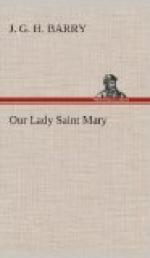And to-day we feel more than ever the need of the doctrine of the assumption. One of the bitterest attacks on the Christian Faith which is being made to-day, emanating principally from within the Christian community, and even from within the Christian ministry, is that which is being made on the truth of the resurrection of the body, whether the resurrection of our Lord, or our own resurrection. In place of the Christian doctrine believed and preached from the beginning, we are asked to lapse back into heathenism and a doctrine of immortality. Not many seem to realise the vastness of the difference that is made in our outlook to the future by a belief in the resurrection of the body as distinguished from immortality. But the character of the religions resulting from these two contrary beliefs is absolutely different. It needs only to study them as they actually exist to be convinced of this fact.
And it is precisely the doctrine of the assumption of our Lady which contributes strong support to the Christian doctrine of the resurrection of the body. It teaches us that in her case the vision and hope of mankind at large has been anticipated and accomplished. The resurrection of our Lord is found, in fact, to extend (if one may so express it) to the members of His mystical body; and the promise which is fulfilled in Blessed Mary, is that hope of a joyful resurrection which is thus confirmed to us all. In its stress upon the assumption the mind of the Christian Church has not been led astray, has not been betrayed into fostering superstitions, but has been led by the Spirit of Christ which He promised it to the development of a truth not only revealing the present place of His glorious Mother in the Kingdom of her Son, but encouraging and heartening us in our following of the heavenly way.
Whoe is shee that assends
so high
Next the
heavenlye Kinge,
Round about whome angells
flie
And her
prayses singe?
Who is shee that adorned
with light,
Makes the
sunne her robe,
At whose feete the queene
of night
Layes her
changing globe?
To that crowne direct
thine eye,
Which her
heade attyres;
There thou mayst her
name discrie
Wrytt in
starry fires.
This is shee, in whose
pure wombe
Heaven’s
Prince remained;
Therefore, in noe earthly
tombe
Cann shee
be contayned.
Heaven shee was, which
held that fire
Whence the
world tooke light,
And to heaven doth now
aspire,
Fflames
with fflames to unite.
Shee that did so clearly
shyne
When our
day begunne,
See, howe bright her
beames decline
Nowe shee
sytts with the sunne.
Sir John Beaumont, 1582-1628.




